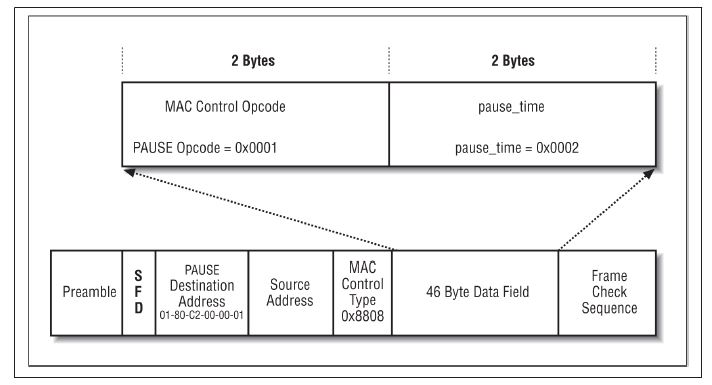PAUSE frames are mechanism used in Ethernet flow control that allows an interface or switch port to send a signal requesting a short pause in frame transmission.
The PAUSE system of flow control on full-duplex link segments, originally defined in 802.3x, uses MAC control frames to carry the PAUSE commands. The MAC control opcode for a PAUSE command is 0x0001 (hex). A station that receives a MAC control frame with this opcode in the first two bytes of the data field knows that the control frame is being used to implement the PAUSE operation, for the purpose of providing flow control on a full-duplex link segment. Only stations configured for full- duplex operation may send PAUSE frames.
When a station equipped with MAC control wishes to send a PAUSE command, it sends a PAUSE frame to the 48-bit destination multicast address of 01-80-C2-00-00-01. This particular multicast address has been reserved for use in PAUSE frames. Having a well- known multicast address simplifies the flow control process by making it unnecessary for a station at one end of the link to discover and store the address of the station at the other end of the link.
Another advantage of using this multicast address arises from the use of flow control on full-duplex segments between switches. The particular multicast address used was selected from a range of addresses reserved by the IEEE 802.1D standard, which specifies basic Ethernet switch (bridge) operation. Normally, a frame with a multicast destination address that is sent to a switch will be forwarded out all other ports of the switch. How‐ ever, this range of multicast addresses is special—they will not be forwarded by an 802.1D-compliant switch. Instead, frames sent to these addresses are understood by the switch to be frames meant to be acted upon within the switch.
A station sending a PAUSE frame to the special multicast address includes not only the PAUSE opcode, but also the period of pause time being requested, in the form of a two- byte integer. This number contains the length of time for which the receiving station is requested to stop transmitting data. The pause time is measured in units of pause “quanta,” where each unit is equal to 512 bit times. The range of possible pause time requests is from 0 through 65,535 units.

Figure 1 shows what a PAUSE frame looks like. The PAUSE frame is carried in the data field of the MAC control frame. The MAC control opcode of 0x0001 indicates that this is a PAUSE frame. The PAUSE frame carries a single parameter, defined as the pause_time in the standard. In this example, the content of pause_time is 2, indicating a request that the device at the other end of the link stop transmitting for a period of two pause quantas (1,024 bit times total).
By using MAC control frames to send PAUSE requests, a station at one end of a full- duplex link can request the station at the other end of the link to stop transmitting frames for a period of time. This provides real-time flow control between switches, or between a switch and a server that are equipped with the optional MAC control software and connected by a full-duplex link.
Unlock Premium Content
Join over 400K+ optical network professionals worldwide. Access premium courses, advanced engineering tools, and exclusive industry insights.
Already have an account? Log in here



